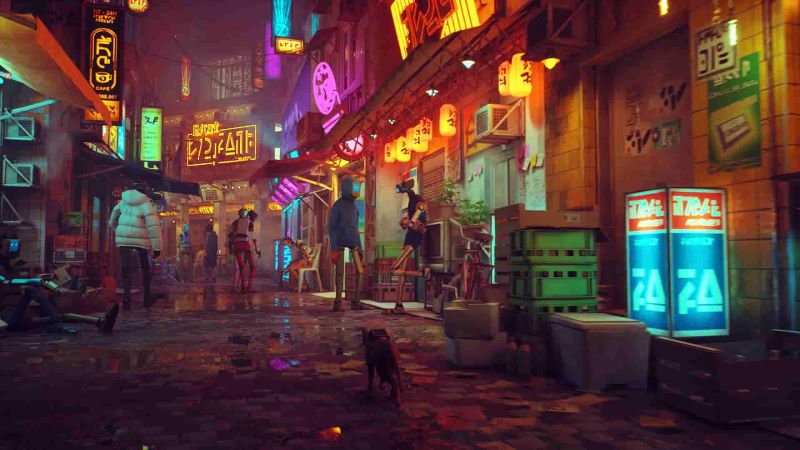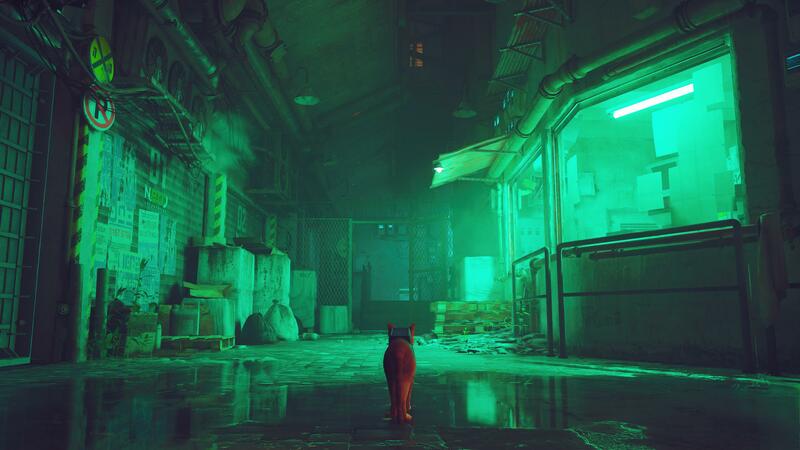Stray PS5 Review. They say curiosity killed the cat – what they didn’t tell you is that curiosity may have also had the cat stumbling upon a neon-soaked underworld ravaged by a pandemic and replete with a wide array of skittish robots.
But that’s exactly where curiosity has led the cat in Stray, French developer BlueTwelve Studio‘s maiden voyage into video game development. And what a voyage it’s turned out to be.
Stray PS5 Review
Stray is a visual tour de force and a confident debut from developer BlueTwelve Studio
As you might expect, Stray has you controlling a lone unnamed cat in a whole manner of ways beyond just movement, from a scratching post mechanism initiated by sequential L2/R2 trigger tapping, to a dedicated ‘meow’ button.
It also freely allows for the sort of contemptuous – yet loveable – behaviour some cats are known for, such as knocking things off of shelves, scratching the carpet, and walking across keyboards (particularly useful for entering passwords). All key gameplay mechanics in their own right as we’ll soon come to realise.
More fundamentally, however, is just how much the cat’s movement is baked into the design of the game – from winding pipework to suspended beams in midair, the world may seem to dwarf this little feline at any given moment but in reality it’s very much attuned to its sensibilities.
What’s perhaps most striking right of the bat is Stray’s visual design, an atmospheric blend of sharp neon with a distinct backdrop of industrial decay and waste. Garish neon arrows aside, the game is positively oozing style, with its varied locales, lighting, and lived-in environments.
It’s the aforementioned pipework that ultimately kicks off proceedings, when an unfortunate leap across a gap leads to injury and leaves us to fend for ourselves. Upon becoming separated from a band of feral cats, our protagonist happens across a densely populated slum, tightly packed with makeshift shops, narrow walkways, and tall interconnected dwellings – all of which just so happen to be a perfect foil for a cat as nimble as our ginger hero.
As you make your way through the slum by scaling buildings, slipping into windows and crevices, you’ll come across the robot inhabitants, many of whom will reference the ‘’Outside” and speak of the dangers that live beyond the safe zone; others will simply barter with you or request that you find them a blanket knitted by a robot grandmother.
Thankfully, you’re not alone as you can rely on help from a little drone companion you meet named B-12, who acts as a translator, item carrier – which is useful as you’ll find yourself collecting trinkets to give to many of the robots – as well as a hacker who can unlock doors or operate different types of machinery. B-12 also gives colour to what is already a visually resplendent game, with its insight, personal story arc, and the way in which it pieces together the various narrative beats as they unfold.
From that, you soon find out that the Zurks – a metal-munching bacterial lifeform that bear a striking similarity to that of Half-Life’s Headcrabs – have effectively ring-fenced these pockets of the robot population into zones, be it the aforementioned slums, a dilapidated tower, or even a sprawling downtown district – and by traveling in packs they have maintained a stranglehold on many of the comparatively docile inhabitants.
In gameplay terms, then, this manifests itself in a sort of divide between hub-like areas and interconnecting linear paths that typically revolve around climbing, light puzzle solving, and stealth. For the former, you’ll be tasked with exploring the area, interacting with the robots, doing side jobs that may serve the critical path, and hunting for collectable ‘memories’ and other translatable scribbles that shed some light on what has transpired in years past.
It’s in these pockets where Stray really purrs, in part due to the visual language and density but perhaps more so because of how your interactions with the robot population shapes the narrative and deepens the intrigue for what’s to come.
With that, though a proverb commonly associated with cats, curiosity is a trait shared by all in the game – a curiosity held by the robots about sentience, about memory, about a world lost, and a world within reach. It also manifests as fear, doubt, and determination. As a consequence, what’s perhaps surprising is just how well Stray delivers its story.
With a strong cast of varied characters across its six-or-so-hour runtime (more if you aim to collect everything) Stray manages to maintain a consistent pacing and rarely ever feels as if it’s going through the motions, perhaps with an exception to what is a slightly plodding start.
Touching upon the visual language point once more, everything within Stray is signposted – perhaps to fault when there’s specific arrows appearing at different points to direct you when it’s obvious where to go – but whether it’s the slapstick nature of a robot lobbing a bucket of paint to a fellow robot across two buildings, to the detail of changing channels on a television, the game often impresses with how it encourages you to tap into a cat’s innately inquisitive nature.
As a testament oftentimes you’ll find yourself interacting and completing certain side quests without having encountered the robot who is to brief you on what is required, and that speaks to how Stray manages to direct you to points of interest organically.
In reality, the divide between the aforementioned hub areas and the Zurk-infested corridors does well for the game’s pacing as it switches up what’s expected of the player; the hub areas are more inquisitive and exploratory and slow proceedings down, while the linear corridors are punctuated by chases, light puzzle work, and climbing.
As the tension climbs and the story progresses, the finicky nature of the controls and camera work do rear their head to a small degree but it’s inconsequential in the grand scheme of things.
Touching on DualSense implementation momentarily, there’s a lot of subtlety at play, with one of the more pronounced effects being when the cat snuggles up in one of the many beds and begins to purr – you can feel it intermittently pulsing through the controller.
Further to that, performance (resisting the urge to spell words beginning with ‘per’ as ‘purr’) is by and large fine, with the odd frame rate dip in the latter half of the game and clipping/collision present a handful of times throughout the adventure – the latter of which is said to be cleaned up in the game’s day one patch (version 1.02) however we’ve been unable to test this at the time of writing.
While it’s taken a number of years for Stray to come to fruition, there’s little doubt that the end result is truly commendable; a meaningful adventure that manages to convey surprising depth and intrigue, and a story for which this lone stray is the perfect conduit to tell it.
Slight technical hiccups don’t detract from what is an accomplished first outing for the Montpellier-based outfit, and though Stray is self-contained and just right length-wise for the story it wants to tell, we can’t help but wish that we could spend more time with its cast of intriguing characters and the layered world that’s been so confidently crafted. What’s here, though, is something special and an adventure that shouldn’t be missed.
Stray releases for PS5, PS4, and PC on July 19, 2022.
Review code provided by PR.



